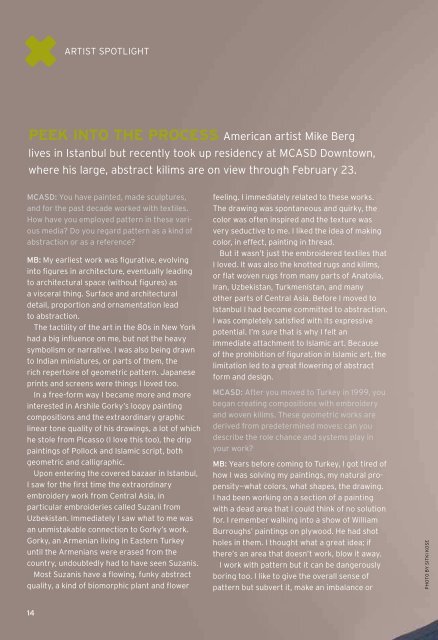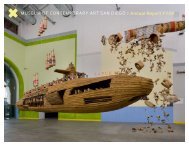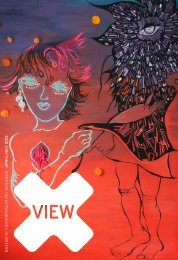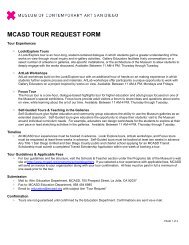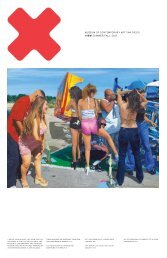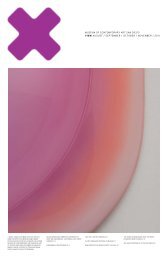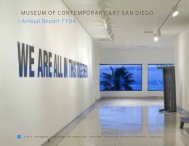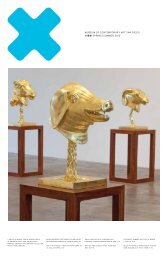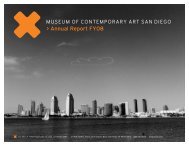December 2013/January/February/March 2014 - Museum of ...
December 2013/January/February/March 2014 - Museum of ...
December 2013/January/February/March 2014 - Museum of ...
- No tags were found...
Create successful ePaper yourself
Turn your PDF publications into a flip-book with our unique Google optimized e-Paper software.
Artist Spotlight<br />
Peek into the Process American artist Mike Berg<br />
lives in Istanbul but recently took up residency at MCASD Downtown,<br />
where his large, abstract kilims are on view through <strong>February</strong> 23.<br />
MCASD: You have painted, made sculptures,<br />
and for the past decade worked with textiles.<br />
How have you employed pattern in these various<br />
media Do you regard pattern as a kind <strong>of</strong><br />
abstraction or as a reference<br />
MB: My earliest work was figurative, evolving<br />
into figures in architecture, eventually leading<br />
to architectural space (without figures) as<br />
a visceral thing. Surface and architectural<br />
detail, proportion and ornamentation lead<br />
to abstraction.<br />
The tactility <strong>of</strong> the art in the 80s in New York<br />
had a big influence on me, but not the heavy<br />
symbolism or narrative. I was also being drawn<br />
to Indian miniatures, or parts <strong>of</strong> them, the<br />
rich repertoire <strong>of</strong> geometric pattern. Japanese<br />
prints and screens were things I loved too.<br />
In a free-form way I became more and more<br />
interested in Arshile Gorky’s loopy painting<br />
compositions and the extraordinary graphic<br />
linear tone quality <strong>of</strong> his drawings, a lot <strong>of</strong> which<br />
he stole from Picasso (I love this too), the drip<br />
paintings <strong>of</strong> Pollock and Islamic script, both<br />
geometric and calligraphic.<br />
Upon entering the covered bazaar in Istanbul,<br />
I saw for the first time the extraordinary<br />
embroidery work from Central Asia, in<br />
particular embroideries called Suzani from<br />
Uzbekistan. Immediately I saw what to me was<br />
an unmistakable connection to Gorky’s work.<br />
Gorky, an Armenian living in Eastern Turkey<br />
until the Armenians were erased from the<br />
country, undoubtedly had to have seen Suzanis.<br />
Most Suzanis have a flowing, funky abstract<br />
quality, a kind <strong>of</strong> biomorphic plant and flower<br />
feeling. I immediately related to these works.<br />
The drawing was spontaneous and quirky, the<br />
color was <strong>of</strong>ten inspired and the texture was<br />
very seductive to me. I liked the idea <strong>of</strong> making<br />
color, in effect, painting in thread.<br />
But it wasn’t just the embroidered textiles that<br />
I loved. It was also the knotted rugs and kilims,<br />
or flat woven rugs from many parts <strong>of</strong> Anatolia,<br />
Iran, Uzbekistan, Turkmenistan, and many<br />
other parts <strong>of</strong> Central Asia. Before I moved to<br />
Istanbul I had become committed to abstraction.<br />
I was completely satisfied with its expressive<br />
potential. I’m sure that is why I felt an<br />
immediate attachment to Islamic art. Because<br />
<strong>of</strong> the prohibition <strong>of</strong> figuration in Islamic art, the<br />
limitation led to a great flowering <strong>of</strong> abstract<br />
form and design.<br />
MCASD: After you moved to Turkey in 1999, you<br />
began creating compositions with embroidery<br />
and woven kilims. These geometric works are<br />
derived from predetermined moves: can you<br />
describe the role chance and systems play in<br />
your work<br />
MB: Years before coming to Turkey, I got tired <strong>of</strong><br />
how I was solving my paintings, my natural propensity—what<br />
colors, what shapes, the drawing.<br />
I had been working on a section <strong>of</strong> a painting<br />
with a dead area that I could think <strong>of</strong> no solution<br />
for. I remember walking into a show <strong>of</strong> William<br />
Burroughs’ paintings on plywood. He had shot<br />
holes in them. I thought what a great idea; if<br />
there’s an area that doesn’t work, blow it away.<br />
I work with pattern but it can be dangerously<br />
boring too. I like to give the overall sense <strong>of</strong><br />
pattern but subvert it, make an imbalance or<br />
PHOTO BY Sitki Kose<br />
distortion. That can happen by establishing a<br />
set <strong>of</strong> rules that have to be followed. There have<br />
been many different sets <strong>of</strong> rules that I’ve used<br />
to create paintings and sculptures, such<br />
as random color or shape selection,<br />
combinations <strong>of</strong> layering, natural<br />
migration <strong>of</strong> a repeated form.<br />
It’s amazing how different<br />
the results can be and it<br />
helps to keep the work<br />
fresh for me. I like not<br />
knowing what a work will<br />
look like until it’s done.<br />
MCASD: What themes<br />
are you investigating in<br />
your current work<br />
MB: The themes <strong>of</strong> my<br />
work don’t change so much,<br />
but the material and techniques<br />
do. I was a painter<br />
for years before I became a<br />
sculptor. The sculptures to<br />
start with were ink drawings.<br />
I imagined line drawings in<br />
space, line drawings minus<br />
the paper mounted <strong>of</strong>f the<br />
wall a short distance away,<br />
casting shadows on the wall.<br />
Later, I had the desire to make<br />
the pieces move into space. I<br />
took flat ink drawings that were<br />
cut in steel and rolled them so they<br />
could stand. I also began to work<br />
with scale; small ink drawings became<br />
large metal sculptures. I like translating<br />
ideas into different materials and<br />
different scales, learning about new<br />
techniques <strong>of</strong> fabrication. Right now I’m<br />
making small scale, almost architectural<br />
designs, that I’m having hand cut by brilliant<br />
craftspeople into minimalist, wearable sculpture.<br />
My focus is always evolving but working<br />
within a basic set <strong>of</strong> principles.<br />
> Mike Berg: Recent Textiles<br />
On view through 2/23/14 > Downtown<br />
14<br />
15


